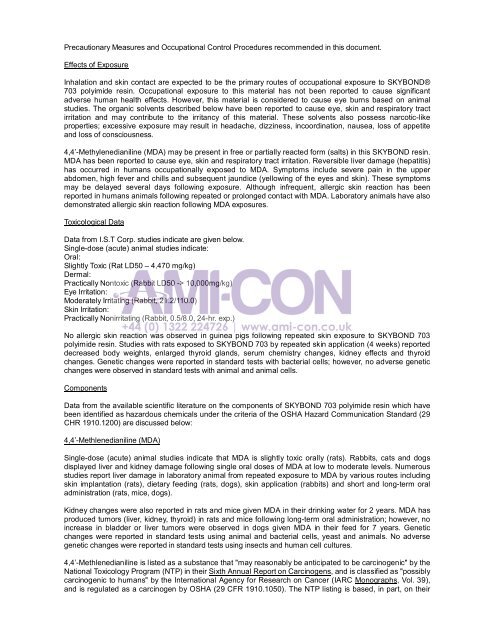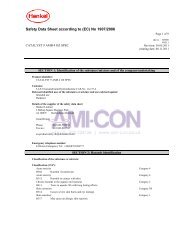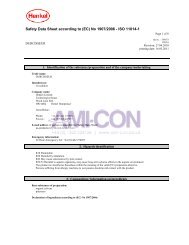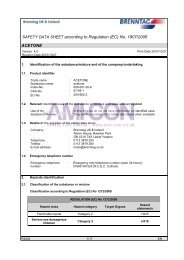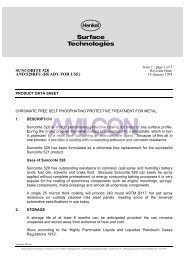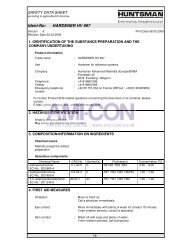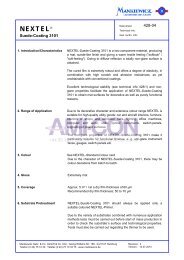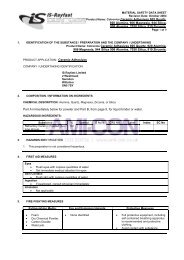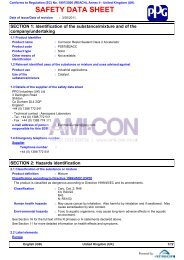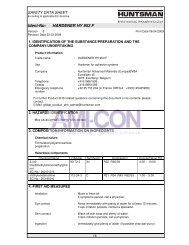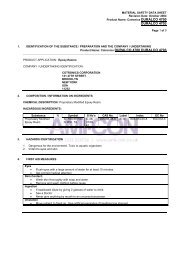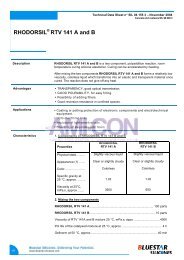Precautionary Measures and Occupational Control Procedures recommended in this document.Effects of ExposureInhalation and skin contact are expected to be the primary routes of occupational exposure to SKYBOND®703 polyimide resin. Occupational exposure to this material has not been reported to cause significantadverse human health effects. However, this material is considered to cause eye burns based on animalstudies. The organic solvents described below have been reported to cause eye, skin and respiratory tractirritation and may contribute to the irritancy of this material. These solvents also possess narcotic-likeproperties; excessive exposure may result in headache, dizziness, incoordination, nausea, loss of appetiteand loss of consciousness.4,4’-Methylenedianiline (MDA) may be present in free or partially reacted form (salts) in this SKYBOND resin.MDA has been reported to cause eye, skin and respiratory tract irritation. Reversible liver damage (hepatitis)has occurred in humans occupationally exposed to MDA. Symptoms include severe pain in the upperabdomen, high fever and chills and subsequent jaundice (yellowing of the eyes and skin). These symptomsmay be delayed several days following exposure. Although infrequent, allergic skin reaction has beenreported in humans animals following repeated or prolonged contact with MDA. Laboratory animals have alsodemonstrated allergic skin reaction following MDA exposures.Toxicological DataData from I.S.T Corp. studies indicate are given below.Single-dose (acute) animal studies indicate:Oral:Slightly Toxic (Rat LD50 – 4,470 mg/kg)Dermal:Practically Nontoxic (Rabbit LD50 -> 10,000mg/kg)Eye Irritation:Moderately Irritating (Rabbit, 21.2/110.0)Skin Irritation:Practically Nonirritating (Rabbit, 0.5/8.0, 24-hr. exp.)No allergic skin reaction was observed in guinea pigs following repeated skin exposure to SKYBOND 703polyimide resin. Studies with rats exposed to SKYBOND 703 by repeated skin application (4 weeks) reporteddecreased body weights, enlarged thyroid glands, serum chemistry changes, kidney effects and thyroidchanges. Genetic changes were reported in standard tests with bacterial cells; however, no adverse geneticchanges were observed in standard tests with animal and animal cells.ComponentsData from the available scientific literature on the components of SKYBOND 703 polyimide resin which havebeen identified as hazardous chemicals under the criteria of the OSHA Hazard Communication Standard (29CHR 1910.1200) are discussed below:4,4’-Methlenedianiline (MDA)Single-dose (acute) animal studies indicate that MDA is slightly toxic orally (rats). Rabbits, cats and dogsdisplayed liver and kidney damage following single oral doses of MDA at low to moderate levels. Numerousstudies report liver damage in laboratory animal from repeated exposure to MDA by various routes includingskin implantation (rats), dietary feeding (rats, dogs), skin application (rabbits) and short and long-term oraladministration (rats, mice, dogs).Kidney changes were also reported in rats and mice given MDA in their drinking water for 2 years. MDA hasproduced tumors (liver, kidney, thyroid) in rats and mice following long-term oral administration; however, noincrease in bladder or liver tumors were observed in dogs given MDA in their feed for 7 years. Geneticchanges were reported in standard tests using animal and bacterial cells, yeast and animals. No adversegenetic changes were reported in standard tests using insects and human cell cultures.4,4’-Methlenedianiline is listed as a substance that "may reasonably be anticipated to be carcinogenic" by theNational Toxicology Program (NTP) in their Sixth Annual Report on Carcinogens, and is classified as "possiblycarcinogenic to humans" by the International Agency for Research on Cancer (IARC Monographs, Vol. 39),and is regulated as a carcinogen by OSHA (29 CFR 1910.1050). The NTP listing is based, in part, on their
determination that "there is sufficient evidence for the carcinogenicity of 4,4’-methylenedianiline inexperimental animals". The IARC listing is based on their determination that "there is sufficient evidence forthe carcinogenicity of MDA I humans and limited evidence for the carcinogenicity of MDA in experimentalanimals". The OSHA listing is also based on the animal data and a NIOSH report which associated elevatedbladder cancer risk with workers exposed to MDA, although OSHA concluded that the evidence in humans"was not conclusive".n-Methylpyrrolidone (NMP)Human experience indicates that continued or gross skin contact with NMP produces irritation, redness anddefatting of the skin. Inhalation of very high concentrations of NMP may result in headache, giddiness,nausea and mental confusion. Repeated dosing of laboratory animals with NMP has been reported to causechanges in organ weights and blood composition, reduced response to sound, and breathing difficulty at adosage which produced death. No skin allergy was observed in guinea pigs following repeated skin exposure.Long-term inhalation (2 years) of NMP produced no increase in tumors in rats and NMP did not show tumorinitiating activity in a mouse skin painting study. Birth defects were reported following dermal application ofNMP to rats at amounts which produced adverse effects on the mother and following intraperitoneal injectionin two strains of mice. No birth defects were reported in rats exposed to NMP by inhalation. No effects wereseen on the ability of rats to reproduce when exposed to NMP for two successive generations, although toxiceffects were reported in offspring at levels which produced adverse effects on the mother. NMP has producedno genetic changes in standard tests using animal and bacterial cells.EthanolIn addition to the irritating effects noted above, swallowing of ethanol also causes nervous system effects andgastrointestinal tract effects; substantial amounts may cause respiratory failure leading to death. Other effectsof ethanol related to repeated intake of alcoholic beverages include nutritional deficiencies, pancreas and liverdamage and blood cell changes. Repeated consumption of ethanol (alcoholic beverages) by pregnant womenis reported to produce adverse effects on the development of their offspring ("fetal alcohol syndrome")Single-dose studies indicate that ethanol is practically nontoxic orally (rats) and after skin application (rabbits)or after inhalation (rats). It is mildly to severely irritating to rabbit eyes and practically nonirritating tomoderately irritating to rabbit skin. It is practically nontoxic by inhalation (rat, LC50 - 20,000 ppm, 10 hourexposure). Various morphological functions and biochemical changes in heart muscle, liver, CNS and bloodcells have been reported for experimental animals given ethanol orally. Repeated inhalation exposuresproduced liver damage in rabbits, while other treatment-related effects were reported in pigs, dogs andmonkeys. Rats exposed by skin application to a 50% solution of ethanol showed only temporary skin irritation.Several species of laboratory animals have been exposed to ethanol by various routes to determine effects onoffspring. While susceptibility varies with each species, birth defects have been consistently reported in manyof the species tested (mouse, rat, pig, guinea pig, monkey). Ethanol produced genetic changes in standardtests using human volunteers and animals and yeast cells. No genetic changes were reported in standardtests using bacterial or animal cells, and negative responses were reported in assays using human cells.Ethanol is listed as a substance which is "carcinogenic to humans" by the International Agency for Researchon Cancer (IARC Monographs Vol. 44). This IRAC listing is based on their determination that althoughinadequate evidence exists for the carcinogenicity of ethanol and alcohol beverages in animals, sufficientevidence exists for the carcinogenicity of alcoholic beverages following long-term consumption of alcoholicbeverages. Epidemiological studies report increased incidence of mouth and throat cancer in humans afterlong-term consumption of alcoholic beverages. Higher risk is associated with the drinking of dark liquors andfor smokers who consume alcoholic beverages.Additional InformationThreshold Limit Value (TLVs) has been established by the American Conference of Governmental <strong>Industrial</strong>Hygienists for ethanol, one of the organic solvents used in SKYBOND 703 polyimide resin, and formethylenedianiline, which may be present as residual monomer in this resin solution. For further informationon these materials, please refer to the current edition on the Documentation of Threshold Limit Values andBiological Exposure Indices.


